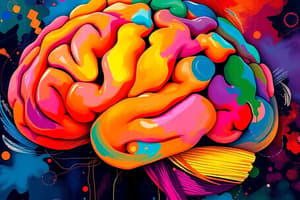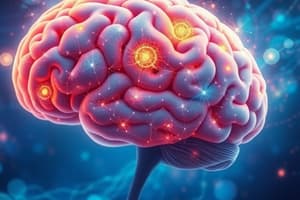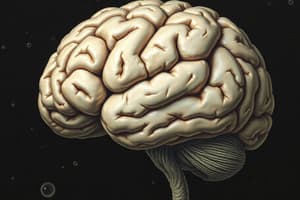Podcast
Questions and Answers
What is one major function of the primate cerebral cortex?
What is one major function of the primate cerebral cortex?
- To store memories permanently
- To initiate reflex actions
- To coordinate complex behaviors and decision-making (correct)
- To process sensory input only
What significant injury did Phineas Gage sustain?
What significant injury did Phineas Gage sustain?
- A deep cut on his cheek
- A metal rod penetrating his prefrontal cortex (correct)
- Severe burns from gunpowder
- A concussion from an explosion
How does spinal cord circuitry compare to the cortex in sensory-to-motor transformations?
How does spinal cord circuitry compare to the cortex in sensory-to-motor transformations?
- Spinal cord circuitry is capable of complex decision-making
- The cortex provides greater flexibility in sensory-to-motor transformations (correct)
- Spinal cord circuitry is more advanced than the cortex
- The spinal cord directly controls all muscle movements
What did Gage's physicians observe about his personality after his injury?
What did Gage's physicians observe about his personality after his injury?
Which part of the nervous system is the first to receive sensory input?
Which part of the nervous system is the first to receive sensory input?
What can be inferred about the role of higher mammals in sensorimotor tasks?
What can be inferred about the role of higher mammals in sensorimotor tasks?
What is a characteristic of rapid, automatic sensory-to-motor transformation?
What is a characteristic of rapid, automatic sensory-to-motor transformation?
Following his injury, what was Gage's condition upon returning to work?
Following his injury, what was Gage's condition upon returning to work?
What did the research primarily train monkeys to categorize?
What did the research primarily train monkeys to categorize?
How many prototypes were used for each category in the study?
How many prototypes were used for each category in the study?
What was the main method used to create the stimuli for categorization?
What was the main method used to create the stimuli for categorization?
What did the monkeys do to indicate they had categorized the images correctly?
What did the monkeys do to indicate they had categorized the images correctly?
What type of tasks did the researchers use in the experiment?
What type of tasks did the researchers use in the experiment?
What was the range of blends generated from the prototypes?
What was the range of blends generated from the prototypes?
What challenge did the monkeys face during the categorization task?
What challenge did the monkeys face during the categorization task?
What feature characterized the morphs used in the study?
What feature characterized the morphs used in the study?
What changes are often observed in patients with frontal lobe lesions?
What changes are often observed in patients with frontal lobe lesions?
Which of the following describes a characteristic behavior of individuals with frontal lobe damage?
Which of the following describes a characteristic behavior of individuals with frontal lobe damage?
What role does the prefrontal cortex play in relation to the sensory and motor systems?
What role does the prefrontal cortex play in relation to the sensory and motor systems?
In the context of executive function, what is the role of the prefrontal cortex?
In the context of executive function, what is the role of the prefrontal cortex?
What does the concept of 'perseveration' refer to in relation to frontal lobe functioning?
What does the concept of 'perseveration' refer to in relation to frontal lobe functioning?
Which structure is responsible for processing auditory information?
Which structure is responsible for processing auditory information?
How are actions generally initiated according to the information provided?
How are actions generally initiated according to the information provided?
What is described by 'top-down' theories of executive function?
What is described by 'top-down' theories of executive function?
Which of the following best defines 'executive control' according to the content?
Which of the following best defines 'executive control' according to the content?
Which area is identified as part of the unimodal cortex?
Which area is identified as part of the unimodal cortex?
How do temporal theories explain executive function?
How do temporal theories explain executive function?
What is the significance of hierarchical organization in the sensory and motor systems?
What is the significance of hierarchical organization in the sensory and motor systems?
What type of cortex is primarily involved in generating motor commands?
What type of cortex is primarily involved in generating motor commands?
Which of the following statements about behavior changes in individuals post-frontal lobe damage is correct?
Which of the following statements about behavior changes in individuals post-frontal lobe damage is correct?
Which sensory area is linked to visual processing in the hierarchy?
Which sensory area is linked to visual processing in the hierarchy?
Which of the following statements about the action and perception relationship is accurate?
Which of the following statements about the action and perception relationship is accurate?
What was the main focus of the study conducted by Wallis, Andersson, and Miller?
What was the main focus of the study conducted by Wallis, Andersson, and Miller?
What percentage of the recorded prefrontal neurons were identified as rule-selective?
What percentage of the recorded prefrontal neurons were identified as rule-selective?
Which task involves identifying the object that does not match the cue?
Which task involves identifying the object that does not match the cue?
How did the monkeys demonstrate their understanding of abstract rules?
How did the monkeys demonstrate their understanding of abstract rules?
What method did Earl Miller and colleagues use to study categorization in monkeys?
What method did Earl Miller and colleagues use to study categorization in monkeys?
What is a key role of the anterior prefrontal cortex (aPFC)?
What is a key role of the anterior prefrontal cortex (aPFC)?
Which statement accurately describes the activity observed in the prefrontal cortex regarding abstract rule encoding?
Which statement accurately describes the activity observed in the prefrontal cortex regarding abstract rule encoding?
How is the connectivity of the aPFC characterized compared to other prefrontal areas?
How is the connectivity of the aPFC characterized compared to other prefrontal areas?
Which rules were the monkeys trained to switch flexibly between?
Which rules were the monkeys trained to switch flexibly between?
What is the fundamental concept of categorization as described in the findings?
What is the fundamental concept of categorization as described in the findings?
What anatomical feature makes the aPFC special compared to other areas of the prefrontal cortex?
What anatomical feature makes the aPFC special compared to other areas of the prefrontal cortex?
In what way has the aPFC evolved compared to other brain areas?
In what way has the aPFC evolved compared to other brain areas?
Which cognitive function is primarily supported by the lateral prefrontal cortex?
Which cognitive function is primarily supported by the lateral prefrontal cortex?
What abilities allow primates to handle novel situations?
What abilities allow primates to handle novel situations?
What ability reflects the primate brain's flexibility in task execution?
What ability reflects the primate brain's flexibility in task execution?
Which area of the prefrontal cortex is specifically associated with contextual control?
Which area of the prefrontal cortex is specifically associated with contextual control?
What kind of operational demand engages the aPFC?
What kind of operational demand engages the aPFC?
What do primates learn about contingencies in their environment?
What do primates learn about contingencies in their environment?
Flashcards
Spinal Cord Circuitry
Spinal Cord Circuitry
The part of the nervous system that receives sensory input and controls movement. It is the first part of the nervous system to receive sensory information.
Rapid Sensory-to-Motor Transformation
Rapid Sensory-to-Motor Transformation
The ability of the spinal cord to quickly convert sensory information into motor commands, often without the brain's involvement.
Sophisticated Sensory-to-Motor Transformations
Sophisticated Sensory-to-Motor Transformations
More complex brain regions, like the cortex, are needed to convert sensory information into actions when the decision to act is based on understanding the meaning of the sensory information, rather than just the raw input.
Prefrontal Cortex
Prefrontal Cortex
Signup and view all the flashcards
Overriding Reflexive Behaviors
Overriding Reflexive Behaviors
Signup and view all the flashcards
Solving Sophisticated Sensory-Motor Transformations
Solving Sophisticated Sensory-Motor Transformations
Signup and view all the flashcards
Phineas Gage Case
Phineas Gage Case
Signup and view all the flashcards
Prefrontal Cortex Damage
Prefrontal Cortex Damage
Signup and view all the flashcards
Acquired Sociopathy
Acquired Sociopathy
Signup and view all the flashcards
Executive Control
Executive Control
Signup and view all the flashcards
Working Memory
Working Memory
Signup and view all the flashcards
Top-Down Attentional Control
Top-Down Attentional Control
Signup and view all the flashcards
Temporal Theory of Executive Control
Temporal Theory of Executive Control
Signup and view all the flashcards
Top-Down Attentional Control
Top-Down Attentional Control
Signup and view all the flashcards
Perseveration
Perseveration
Signup and view all the flashcards
Sensory Hierarchy
Sensory Hierarchy
Signup and view all the flashcards
Motor Hierarchy
Motor Hierarchy
Signup and view all the flashcards
Supramodal Cortex
Supramodal Cortex
Signup and view all the flashcards
Unimodal Cortex
Unimodal Cortex
Signup and view all the flashcards
Hierarchical Processing
Hierarchical Processing
Signup and view all the flashcards
Internally Generated Actions
Internally Generated Actions
Signup and view all the flashcards
Stimulus-Guided Actions
Stimulus-Guided Actions
Signup and view all the flashcards
Rule-selective neurons
Rule-selective neurons
Signup and view all the flashcards
Rule Abstraction
Rule Abstraction
Signup and view all the flashcards
Delayed matching to sample task
Delayed matching to sample task
Signup and view all the flashcards
Delayed non-matching to sample task
Delayed non-matching to sample task
Signup and view all the flashcards
Flexible rule switching
Flexible rule switching
Signup and view all the flashcards
Categorization
Categorization
Signup and view all the flashcards
Contextual Control
Contextual Control
Signup and view all the flashcards
Wallis, Andersson and Miller (2001)
Wallis, Andersson and Miller (2001)
Signup and view all the flashcards
Contextual Control (Specific)
Contextual Control (Specific)
Signup and view all the flashcards
Selection Control
Selection Control
Signup and view all the flashcards
Anterior Prefrontal Cortex (aPFC)
Anterior Prefrontal Cortex (aPFC)
Signup and view all the flashcards
aPFC Connectivity
aPFC Connectivity
Signup and view all the flashcards
aPFC Evolution
aPFC Evolution
Signup and view all the flashcards
aPFC Synaptic Integration
aPFC Synaptic Integration
Signup and view all the flashcards
Bridging Temporal Gaps
Bridging Temporal Gaps
Signup and view all the flashcards
Contingencies and Rules
Contingencies and Rules
Signup and view all the flashcards
Category Generalization
Category Generalization
Signup and view all the flashcards
Delayed Match to Category Task
Delayed Match to Category Task
Signup and view all the flashcards
Category Boundary
Category Boundary
Signup and view all the flashcards
Morphing Program
Morphing Program
Signup and view all the flashcards
Prototype
Prototype
Signup and view all the flashcards
Morphs
Morphs
Signup and view all the flashcards
Category Boundary Performance
Category Boundary Performance
Signup and view all the flashcards
Stimuli Set
Stimuli Set
Signup and view all the flashcards
Study Notes
Prefrontal Cortex: Overview
- The prefrontal cortex is the highest level of the brain's hierarchical system for integrating sensory perception and motor actions, crucial for cognitive control.
- It's crucial for advanced cognitive processes like flexible decision-making, novel problem solving, and controlling impulses.
- The prefrontal cortex is uniquely connected to other areas in the brain; crucial for processing input from and sending output to different brain regions.
- Damage to the prefrontal cortex can profoundly impact personality and behavior, as evidenced by Phineas Gage's case study.
Spinal Cord Circuitry
- The spinal cord is the earliest part of the nervous system to receive sensory input.
- It performs rapid automatic sensory-to-motor transformations, independent of the brain.
- The spinal cord's circuitry is fundamental for basic reflexes and motor responses.
How the Motor System Accesses Sensory Information
- Spinal cord circuits are basic and not capable of sophisticated sensory-to-motor transformations.
- Higher mammals (like primates) use their cortex to smoothly transform sensory input into action with flexibility.
- The primate cerebral cortex coordinates complex behaviors and solves problems related to sensory-motor transformations.
Phineas Gage Case Study
- Phineas Gage was a 19th-century railroad worker who survived a severe brain injury.
- An iron rod pierced his prefrontal cortex, leading to significant behavioral and personality changes.
- His physician documented his now-impulsive, irreverent, and profanity-prone behavior; before and after the accident his behavior was very different.
Prefrontal Cortex Anatomy and Function
- The prefrontal cortex is subdivided into regions impacting distinct aspects of cognitive control.
- Prefrontal neurons play a vital role in processing information; this processing is more complex and abstract than in other brain regions.
- The prefrontal cortex is the highest level of brain hierarchy, responsible for complex cognitive processing, involving planning, complex decision-making, and bridging temporal gaps.
Executive Control
- Executive function enables freedom from reacting to immediate stimuli by prioritizing goals.
- There are two main accounts, temporal theories and top-down theories, of how executive control functions.
- Temporal theories focus on information maintenance and manipulation in working memory and the handling of cross-temporal contingencies.
- Top-down theories are about attentional supervision in higher brain regions in order to control lower brain regions by setting goals and attending/responding to goals.
Prefrontal Cortex & Working Memory
- The delayed response task is crucial for understanding prefrontal cortex and working memory.
- Working memory involves applying rules to actively represent information not presently perceived.
- Delayed matching-to-sample tasks demonstrate the importance of prefrontal cortex in retaining information for action selection.
Prefrontal Cortex & Working Memory - Neural Activity
- Prefrontal neuronal activity reflects the active maintenance of information during working memory tasks.
- Delay period activity has been shown to reflect information retention in prefrontal cortex.
- Some neurons show sustained activity during the delay period, related to keeping track of information and making selections.
Distraction-Resistant Memory & Prefrontal Cortex
- Prefrontal cortex area 46 is associated with a distractor-resistant memory.
- This is shown in tests where sustaining information over a delay is related to activity in the prefrontal cortex.
Abstractions of Rules and Learning
- The brain can abstract rules as representations based on the similarities of different experiences.
- The prefrontal cortex helps bridge the gap between actions in the moment and planned actions to achieve long-term goals.
Prefrontal Cortex and Encoding Rules
- Flexible primate behavior is dependent on rules that can be applied to various situations.
- Prefrontal cortex neurons might encode abstract rules that allow the brain to apply those rules to various situations.
- Through tasks like matching to sample, and non-matching to sample tasks, understanding how rules are encoded and applied in the PFC becomes possible.
Rule Selective Neurons
- Prefrontal neurons code for rules through processes reflecting and differentiating between different situations.
- Prefrontal cortex neurons selectively respond to specific rules in different contexts.
- Researchers identified that rule-selective neurons were the predominant type in the prefrontal cortex.
Categorisation and Perceptual Categories
- The prefrontal cortex enables categorisation by processing information about the similarities between stimuli across various instances.
- Monkeys have been trained on categorization tasks involving distinguishing between categories (like "cat" vs. "dog").
Prefrontal Cortex and Working Memory - Further Considerations
- There are different models to explain PFC function, providing varied perspectives on how the prefrontal cortex processes information.
- How flexible is coding in PFC neurons? The flexibility of coding in specific prefrontal neurons is being studied.
- Further investigation is needed into how other brain areas are interconnected with the prefrontal cortex.
Studying That Suits You
Use AI to generate personalized quizzes and flashcards to suit your learning preferences.




